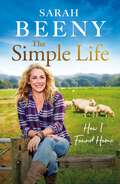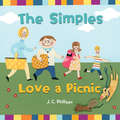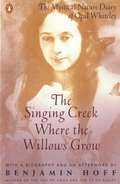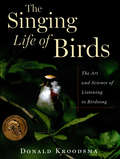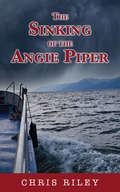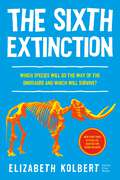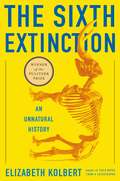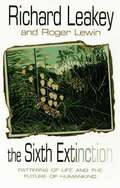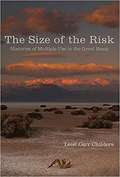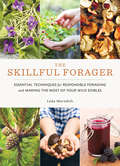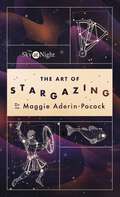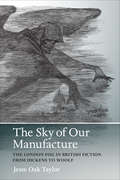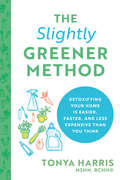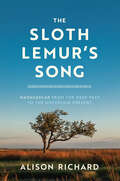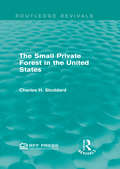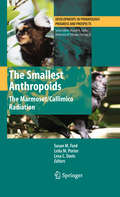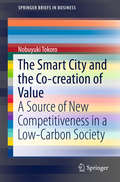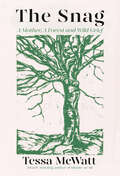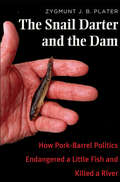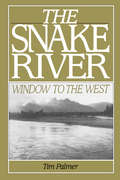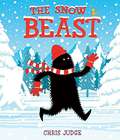- Table View
- List View
The Simple Life: The unmissable memoir from one of Britain’s most loved presenters
by Sarah BeenyJoin Sarah Beeny on her journey to live more simply and find her forever home...Throughout her life, Sarah Beeny has been obsessed with the idea of home. From her childhood growing up in a countryside cottage to renovating her very first flat in London to restoring a stately home in Yorkshire, she has never been afraid of the hard work needed to turn a house into a home. Now, in her most recent adventure, Sarah and her family have moved to a former dairy farm in Somerset to build the home of their dreams. In The Simple Life, Sarah will tell the story of her life, sharing tales and experiences in everything including parenting, property, friendships, nature and the environment, all the way through to her recent cancer diagnosis and treatment. Through it all, Sarah tackles challenges and troubles with signature wit and wisdom, discovering life is never as 'simple' as you'd like it to be.
The Simples Love a Picnic
by J. C. PhillippsThe Simple family's plans for a picnic in the park prove disastrously complex. From the artist and author J. C. Phillipps comes this hilarious little picture book with a big heart to remind us that picnics are just a little about food and a lot about family.
The Singing Creek Where The Willows Grow: The Mystical Nature Diary Of Opal Whiteley
by Benjamin Hoff Opal WhiteleyLong before environmental consciousness became popular, a young nature writer named Opal Whitely captured America's heart. Opal's childhood diary, published in 1902, became an immediate bestseller, one of the most talked-about books of its time. Wistful, funny, and wise, it was described by an admirer as "the revelation of the ...life of a feminine Peter Pan of the Oregon wilderness-so innocent, so intimate, so haunting, that I should not know where in all literature to look for a counterpart." But the diary soon fell into disgrace. Condemning it as an adult-written hoax, skeptics stirred a scandal that drove the book into obscurity and shattered the frail spirit of its author. Discovering the diary by chance, bestselling author Benjamin Hoff set out to solve the longstanding mystery of its origin. His biography of Opal that accompanies the diary provides fascinating proof that the document is indeed authentic-the work of a magically gifted child, America's forgotten interpreter of nature.
The Singing Life of Birds
by Donald KroodsmaListen to birds sing as you've never listened before, as the world-renowned birdsong expert Donald Kroodsma takes you on personal journeys of discovery and intrigue. Read stories of wrens and robins, thrushes and thrashers, warblers and whip-poor-wills, bluebirds and cardinals, and many more bird. Learn how each acquires its songs, how songs vary from bird to bird and place to place, how some birds' singing is especially beautiful or ceaseless or complex, how some do not sing at all, how the often quiet female has the last word, and why. Hear a baby wren and the author's own daughter babble as each learns its local dialect. Listen to the mockingbird by night and by day and count how many different songs he can sing. Marvel at the exquisite harmony in the duet of a wood thrush as he uses his two voice boxes to accompany himself. Feel the extraordinary energy in the songs just before sunrise as dawn's first light sweeps across this singing planet. Hear firsthand the unmistakable evidence that there are not one but two species of marsh wrens and two species of winter wrens in North America. Learn not only to hear but to see birds sing in the form of sonagrams, as these visual images dance across the pages while you listen to the accompanying audio. Using your trained ears and eyes, you can begin your own journeys of discovery. Listen anew to birds in your backyard and beyond, exploring the singing minds of birds as they tell all that they know. Join Kroodsma not only in identifying but in identifying with singing birds, connecting with nature's musicians in a whole new way. Please note: this ebook includes embedded audio files. You will only be able to access these files from a device that supports embedded audio.
The Sinking of the Angie Piper
by Chris RileyA thrilling adventure about one of the most dangerous jobs in the world—crab fishing—in “the debut of an exciting new voice that you must not miss” (James Rollins, #1 New York Times–bestselling author of The Bone Labyrinth). Ed and his childhood friend Danny are in Kodiak, Alaska, preparing to join the Angie Piper’s crew for another season of crab fishing. And while Ed is a relative newcomer to the perilous trade, he sees no reason to fear for Danny’s safety. After all, the Angie Piper has always been blessed with a stalwart captain, a crack engineer, and two time-tested pros to keep the operation running smoothly. Every season has a greenhorn, the one who works for a pittance while learning the ropes. This time around it’s Danny. Brave and hardworking, Danny is a simple soul. And Ed is still haunted by the bullying Danny received as a child. But the cantankerous engineer believes a man like Danny is a bad omen, so much so that his bitter opposition may endanger them all. The season starts off strong, but their luck soon turns. The skies grow dark, the waves swell, and Mother Nature bears down on them with her full arsenal. The only question is—when the storm finally subsides, who will be left to tell the tale?
The Sixth Element: How Carbon Shapes Our World
by Theodore P. Snow Don BrownleeA cosmic perspective on carbon—its importance in the universe and our livesWhen we think of carbon, we might first think of a simple element near the top of the periodic table: symbol C, atomic number 6. Alternatively, we might think of something more tangible—a sooty piece of coal or a sparkling diamond, both made of carbon. Or, as Earth&’s temperature continues to rise alarmingly, we might think of the role carbon plays in climate change. Yet carbon&’s story begins long ago, far from earthly concerns. In The Sixth Element, astronomers Theodore Snow and Don Brownlee tell the story of carbon from a cosmic perspective—how it was born in the fiery furnaces of stars, what special chemical and physical properties it has, and how it forms the chemical backbone of the planets and all life as we know it. Foundational to every part of our lives, from our bodies to the food, tools, and atmosphere that sustain our existence, carbon is arguably humankind&’s most important element.Snow and Brownlee offer readers the ideal introduction to the starry element that made our world possible and shapes our lives. They first discuss carbon&’s origin, discovery, and unique ability to bond with other elements and form countless molecules. Next, they reveal carbon&’s essential role in the chemical evolution of the universe and the formation and evolution of galaxies, stars, planets, and life, and then, more generally, its technological uses and its influence on Earth&’s climate. Bringing readers on a historical, scientific, and cross-disciplinary journey, The Sixth Element illuminates the cosmic wonder that is carbon.
The Sixth Extinction (young readers adaptation): An Unnatural History
by Elizabeth KolbertIn this young readers adaptation of the New York Times-bestselling, Pulitzer Prize-winning The Sixth Extinction, Elizabeth Kolbert tells us why and how human beings have altered life on the planet in a way no species has before. Over the last half-billion years, there have been five mass extinctions, when the diversity of life on earth suddenly and dramatically contracted. Scientists around the world are monitoring the sixth extinction, predicted to be the most devastating extinction event since the asteroid impact that wiped out the dinosaurs. Adapting from her New York Times-bestselling, Pulitzer Prize-winning adult nonfiction, Elizabeth Kolbert explores how humans are altering life on Earth.
The Sixth Extinction: An Unnatural History
by Elizabeth KolbertA major book about the future of the world, blending intellectual and natural history and field reporting into a powerful account of the mass extinction unfolding before our eyes.<p><p> Over the last half a billion years, there have been five mass extinctions, when the diversity of life on earth suddenly and dramatically contracted. Scientists around the world are currently monitoring the sixth extinction, predicted to be the most devastating extinction event since the asteroid impact that wiped out the dinosaurs. This time around, the cataclysm is us. <p> In The Sixth Extinction, two-time winner of the National Magazine Award and New Yorker writer Elizabeth Kolbert draws on the work of scores of researchers in half a dozen disciplines, accompanying many of them into the field: geologists who study deep ocean cores, botanists who follow the tree line as it climbs up the Andes, marine biologists who dive off the Great Barrier Reef. She introduces us to a dozen species, some already gone, others facing extinction, including the Panamian golden frog, staghorn coral, the great auk, and the Sumatran rhino. <p> Through these stories, Kolbert provides a moving account of the disappearances occurring all around us and traces the evolution of extinction as concept, from its first articulation by Georges Cuvier in revolutionary Paris up through the present day. The sixth extinction is likely to be mankind's most lasting legacy; as Kolbert observes, it compels us to rethink the fundamental question of what it means to be human. <p> Pulitzer Prize Winner
The Sixth Extinction: Patterns Of Life And The Future Of Humankind
by Richard E. Leakey Roger LewinTo the philosophical the earth is eternal, while the human race -- presumptive keeper of the world's history -- is a mere speck in the rich stream of life. It is known that nothing upon Earth is forever; geography, climate, and plant and animal life are all subject to radical change. On five occasions in the past, catastrophic natural events have caused mass extinctions on Earth. But today humans stand alone, in dubious distinction, among Earth's species: "Homo Sapiens possesses the ability to destroy entire species at will, to trigger the sixth extinction in the history of life. In "The Sixth Extinction, Richard Leakey and Roger Lewin consider how the grand sprawl of human life is inexorably wreaking havoc around the world. The authors of "Origins and "Origins Reconsidered, unimpeachable authorities on the human fossil record, turn their attention to the most uncharted anthropological territory of all: the future, and man's role in defining it. According to Leakey and Lewin, man and his surrounding species are end products of history and chance. Now, however, humans have the unique opportunity to recognize their influence on the global ecosystem, and consciously steer the outcome in order to avoid triggering an unimaginable upheaval.
The Size of the Risk: Histories of Multiple Use in the Great Basin
by Leisl Carr-ChildersThe Great Basin, a stark and beautiful desert filled with sagebrush deserts and mountain ranges, is the epicenter for public lands conflicts. Arising out of the multiple, often incompatible uses created throughout the twentieth century, these struggles reveal the tension inherent within the multiple use concept, a management philosophy that promises equitable access to the region’s resources and economic gain to those who live there. <p><p> Multiple use was originally conceived as a way to legitimize the historical use of public lands for grazing without precluding future uses, such as outdoor recreation, weapons development, and wildlife management. It was applied to the Great Basin to bring the region, once seen as worthless, into the national economic fold. Land managers, ranchers, mining interests, wilderness and wildlife advocates, outdoor recreationists, and even the military adopted this ideology to accommodate, promote, and sanction a multitude of activities on public lands, particularly those overseen by the Bureau of Land Management. Some of these uses are locally driven and others are nationally mandated, but all have exacted a cost from the region’s human and natural environment. <p><p> In The Size of the Risk, Leisl Carr Childers shows how different constituencies worked to fill the presumed “empty space” of the Great Basin with a variety of land-use regimes that overlapped, conflicted, and ultimately harmed the environment and the people who depended on the region for their livelihoods. She looks at the conflicts that arose from the intersection of an ever-increasing number of activities, such as nuclear testing and wild horse preservation, and how Great Basin residents have navigated these conflicts. <p><p> Carr Childers’s study of multiple use in the Great Basin highlights the complex interplay between the state, society, and the environment, allowing us to better understand the ongoing reality of living in the American West.
The Skeptical Environmentalist: Measuring the Real State of the World
by Bjørn LomborgThe Skeptical Environmentalist challenges widely held beliefs that the environmental situation is getting worse and worse and is critical of the way in which many environmental organizations make selective and misleading use of the scientific evidence. Using the best available statistical information from internationally recognized research institutes, it systematically examines a range of major environmental problems that feature prominently in headline news across the world.
The Skillful Forager: Essential Techniques for Responsible Foraging and Making the Most of Your Wild Edibles
by Leda MeredithThe Skillful Forager is the ultimate forager’s guide to working with any wild plant in the field, kitchen, or pantry. From harvesting skills that will allow you to gather from the same plant again and again to highlighting how to get the most out of each and every type of wild edible, trusted expert Leda Meredith explores the most effective ways to harvest, preserve, and prepare all of your foraged foods. Featuring detailed identification information for over forty wild edibles commonly found across North America, the plant profiles in this book focus on sustainable harvesting techniques that can be applied to hundreds of other plants. This indispensable reference also provides simple recipes that can help you make the most of your harvest each season.
The Sky at Night: My Essential Guide to Navigating the Night Sky
by Dr Maggie Aderin-PocockLook up...The Art of Stargazing is the ultimate insider's guide to the night sky in which award-winning space scientist and The Sky at Night presenter Dr Maggie Aderin-Pocock shares her expertise and unique insights into the marvellous world of stars. Take a tour of the 88 constellations and explore the science, history, culture and romanticism behind these celestial bodies.In this must-have handbook for budding stargazers - and anyone looking for a little more wonder in their lives - Maggie will help you to identify stars and teach you the basics of naked-eye observation, offering fascinating facts plus advice on kit, 'dark sky' locations and much more. Also included are beautiful illustrations to accompany each constellation and an easy-to-read sky map. With Maggie by your side, the night sky will truly come alive.
The Sky of Our Manufacture: The London Fog in British Fiction from Dickens to Woolf (Under the Sign of Nature: Explorations in Ecocriticism)
by Jesse Oak TaylorThe smoke-laden fog of London is one of the most vivid elements in English literature, richly suggestive and blurring boundaries between nature and society in compelling ways. In The Sky of Our Manufacture, Jesse Oak Taylor uses the many depictions of the London fog in the late nineteenth- and early twentieth-century novel to explore the emergence of anthropogenic climate change. In the process, Taylor argues for the importance of fiction in understanding climatic shifts, environmental pollution, and ecological collapse. The London fog earned the portmanteau "smog" in 1905, a significant recognition of what was arguably the first instance of a climatic phenomenon manufactured by modern industry. Tracing the path to this awareness opens a critical vantage point on the Anthropocene, a new geologic age in which the transformation of humanity into a climate-changing force has not only altered our physical atmosphere but imbued it with new meanings. The book examines enduringly popular works--from the novels of Charles Dickens and George Eliot to Dr. Jekyll and Mr. Hyde, Dracula, and the Sherlock Holmes mysteries to works by Joseph Conrad and Virginia Woolf--alongside newspaper cartoons, scientific writings, and meteorological technologies to reveal a fascinating relationship between our cultural climate and the sky overhead. Under the Sign of Nature: Studies in Ecocriticism
The Slightly Greener Method: Detoxifying Your Home Is Easier, Faster, and Less Expensive than You Think
by Tonya HarrisFrom the foods you consume to the household and personal care products you buy, being just slightly greener can have a big impact on your health and happiness!The Slightly Greener Method gives you small, actionable changes you can easily make in three areas of your home—the kitchen (foods and beverages), bathroom (personal care products and cosmetics), and cleaning products—without breaking the bank or upending your life.You don't have to be 100% chemical free to be healthier and safer. By focusing on micro-habits you can build over time and the gradual introduction of non-toxic, all-natural or organic, eco-friendly products, board-certified holistic nutritionist Tonya Harris guides you along a roadmap to a greener, more environmentally-friendly and sustainable lifestyle that can help protect you and your families' health long-term.Get answers to questions like:What does "organic" really mean?Which of the unpronounceable chemicals listed on the back of my shampoo bottle might be toxic?Do I really need to throw away expired makeup?Why aren't companies always required to list toxic ingredients on their product labels?How can I make sure my kids and pets are safe while also keeping a squeaky clean house?It's never too soon (or too late) to start your slightly greener journey! This practical, actionable guide is perfect for readers of bestselling lifestyle and organizational books such as The Complete Book of Clean and Zero Waste Home, and fans of TV shows like Tidying Up with Marie Kondo and The Home Edit.
The Sloth Lemur's Song: Madagascar from the Deep Past to the Uncertain Present
by Alison RichardA moving account of Madagascar told by a researcher who has spent over fifty years investigating the mysteries of this remarkable island. Madagascar is a place of change. A biodiversity hotspot and the fourth largest island on the planet, it has been home to a spectacular parade of animals, from giant flightless birds and giant tortoises on the ground to agile lemurs leaping through the treetops. Some species live on; many have vanished in the distant or recent past. Over vast stretches of time, Madagascar’s forests have expanded and contracted in response to shifting climates, and the hand of people is clear in changes during the last thousand years or so. Today, Madagascar is a microcosm of global trends. What happens there in the decades ahead can, perhaps, suggest ways to help turn the tide on the environmental crisis now sweeping the world. The Sloth Lemur’s Song is a far-reaching account of Madagascar’s past and present, led by an expert guide who has immersed herself in research and conservation activities with village communities on the island for nearly fifty years. Alison Richard accompanies the reader on a journey through space and time—from Madagascar’s ancient origins as a landlocked region of Gondwana and its emergence as an island to the modern-day developments that make the survival of its array of plants and animals increasingly uncertain. Weaving together scientific evidence with Richard’s own experiences and exploring the power of stories to shape our understanding of events, this book captures the magic as well as the tensions that swirl around this island nation.
The Small Private Forest in the United States (Routledge Revivals)
by Charles H. StoddardThroughout the past few decades, the standard answer to the problem of low productivity in small private forests has been education. It has been assumed that the chief obstacle to "good" forestry has been lack of knowledge. But the stubborn persistence of the problem raises some doubts as to the efficacy of the remedy. In this book, first published in 1961, the author takes a sharper look at this problem. He tries to find out what has worked reasonably well, and what has not, and makes some suggestions as to what seems to offer the best prospects for the future. The Small Private Forest in the United States will be of interest to students of environmental studies, as well as to private landowners.
The Smallest Anthropoids
by Leila M. Porter Susan M. Ford Lesa C. DavisThis volume represents a comprehensive examination of the newly recognized callimico/marmoset clade, which includes the smallest anthropoid primates on earth. It will explore these diminutive primates in their entirety, with sections on phylogeny, taxonomy and functional anatomy, behavioral ecology, reproductive physiology, as well as address critical conservation issues and the need for conservation action. The topics specifically selected for this volume are pivotal for understanding the evolutionary adaptations and divergence of any primate group, and especially one as diverse and curious as this. The discoveries of new taxa over the last fifteen years along with new genetic data have transformed this group from three genera (one with only a distant relationship to the others) and five recognized species, to five closely related genera, comprising at least 22 species. This volume will be the first to synthesize data on these newly recognized taxa. This volume is an international endeavor, bringing together primary callimico and marmoset researchers from around the globe, including Brazil and the United States as well as Greece, Italy, Switzerland, and Germany. One of the merits of this volume is that it will serve as a readily accessible work that includes the major findings of several key international researchers whose work has not been easily available to English-speaking scholars. In addition, it draws together lab and field researchers, geneticists, anatomists, and behaviorists in an integrated volume that will provide the most detailed and thorough work on either callimicos or marmosets to date. This volume will also provide a timely forum for identifying future avenues of action necessary for more fully understanding and protecting this intriguing primate radiation.
The Smart City and the Co-creation of Value
by Nobuyuki TokoroThe original point that differentiates this text from otherwise similar texts is that it looks at the building of smart cities from the viewpoint of an interchange of knowledge among companies in different industries, or "Ba" as shared context in motion, and emphasizes that the resulting value becomes a source of new corporate competitive advantage. In recent years numerous publications have appeared that analyze smart cities from various perspectives including urban planning and administration, network theory, and innovation. However, few are academic texts that approach the subject from the viewpoint of corporate competitive advantage against a theoretical background in management studies, as this one does. This book is the first full-scale academic work to analyze smart cities from the viewpoint of corporate competitive advantage. Research into corporate competitive advantage includes the positioning and the resource-based views, with the former focusing on companies' external environment and the latter on their internal resources. Although these theories' foci of attention necessarily differ, they both developed as tools for analyzing companies' relative merits and their chances of succeeding in the marketplace, and they take the common premise that competitive advantage is built through competition among companies. In contrast, this book sees corporate competitive advantage as arising not through competition but through "co-creation" among companies. It differs in its approach from existing theories in thinking that emphasizing co-creation over competition enables an analysis that better describes actual conditions when considering smart cities and corporate competitive advantage. Put another way, when new values arise from attempts to exchange and fuse knowledge, expertise, and other factors at the "ba" where companies from different industries collaborate, these values are surely brought about through co-creation among companies. Another point regarding this book's original perspective on competitive advantage is its emphasis on the relationship between the creation of social value and competitive advantage. The question of the extent to which socially useful values can be created in the markets of the 21st century is closely linked to corporate competitive advantage. The issues of building smart cities and corporate competitive advantage are themes that this perspective can firmly grasp. This book intends to take up three different projects from among the smart-city building developments taking shape in Japan, and undertake case studies based on the theoretical framework outlined above. The central themes will analyze the mechanism of co-creation among companies and the relationship of created value to competitive advantage. This analysis aims to demonstrate one model relating to corporate competitive advantage in the 21st century.
The Snag: A Mother, A Forest, and Wild Grief
by Tessa McWattIn her memoir The Snag, the acclaimed, award-winning author of Shame on Me, Tessa McWatt, takes on personal and collective grief, and the solace and inspiration to be found in connecting with nature—and each other.Every day, we hear about and experience griefs, large and small, in our families, friendships, communities, and worldwide. The grief of a loved one passing. The grief of a way of life ceasing to exist. The grief of global pandemic, war, climate collapse.As her mother&’s dementia advances and she can no longer live independently, Tessa McWatt confronts personal and political losses, and finds herself wandering in a forest asking, how do we grieve? And what can we learn from nature and those whose communities are rooted in nature about not only how to grieve but also how to live?From the newest seedling to the oldest snag in the forest, there is meaning to be found in every stage of a tree&’s life, all of which contribute to a thriving forest community. In this forest thinking, Tessa begins to find answers to her questions about how to live (for each other), how to grieve (radically), and how to die (with love and connection).The Snag is an essential book about living and dancing and singing and praying, even in the face of unimaginable sadness, and in this way, growing together and supporting one another, like the trees in the forest.
The Snail Darter and the Dam
by Zygmunt Jan PlaterEven today, thirty years after the legal battles to save the endangered snail darter, the little fish that blocked completion of a TVA dam is still invoked as an icon of leftist extremism and governmental foolishness. In this eye-opening book, the lawyer who with his students fought and won the Supreme Court case--known officially as Tennessee Valley Authority v. Hill--tells the hidden story behind one of the nation's most significant environmental law battles.The realities of the darter's case, Plater asserts, have been consistently mischaracterized in politics and the media. This book offers a detailed account of the six-year crusade against a pork-barrel project that made no economic sense and was flawed from the start. In reality TVA's project was designed for recreation and real estate development. And at the heart of the little group fighting the project in the courts and Congress were family farmers trying to save their homes and farms, most of which were to be resold in a corporate land development scheme. Plater's gripping tale of citizens navigating the tangled corridors of national power stimulates important questions about our nation's governance, and at last sets the snail darter's record straight.
The Snake River Challenge (Lucky Luke's Hunting Adventures)
by Kevin Lovegreen James Monroe Design Angela WiechmannJoin Lucky Luke and his family as they tackle the amazing Snake River in Idaho. Mom and Dad are excited to take Luke and his sister Crystal along on their annual fly-fishing trip. See all the excitement and the learning as Luke and Crystal experience their first fly fishing adventure. This story has it all, family fun, lessons learned, amazing scenery and the tremendous trout put on show.
The Snake River: Window To The West
by Tim PalmerTim Palmer weaves natural history into a comprehensive account of the complex problems that plague natural resource management throughout the West, as well as the practical solutions that are available.
The Snow Beast (The Beast #3)
by Chris JudgeThe villagers cannot put on their legendary Winter Party when they are robbed of their tools, so Beast sets off to find who stole them, then befriends the snow beast criminal who returns the tools and is forgiven by the village.
